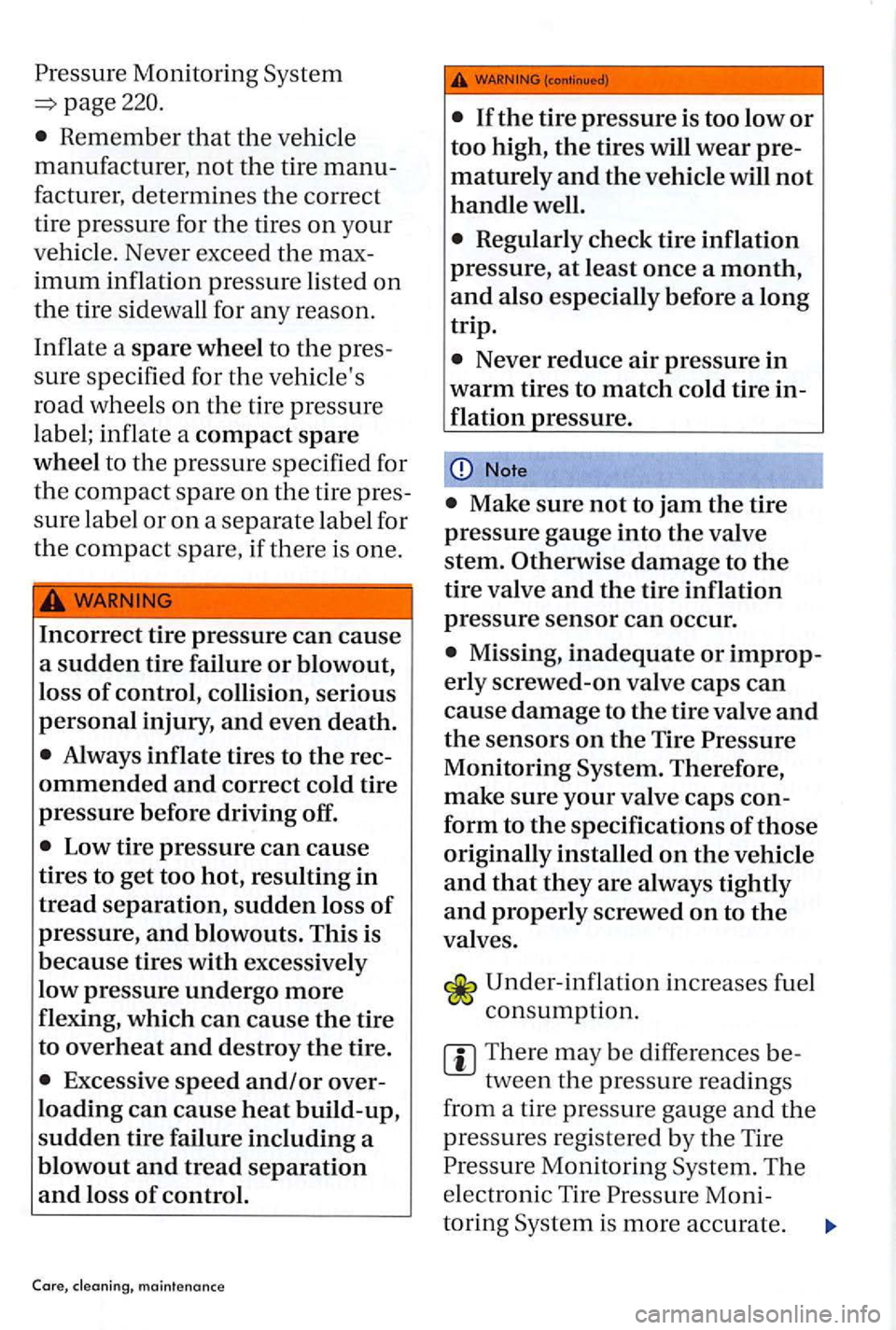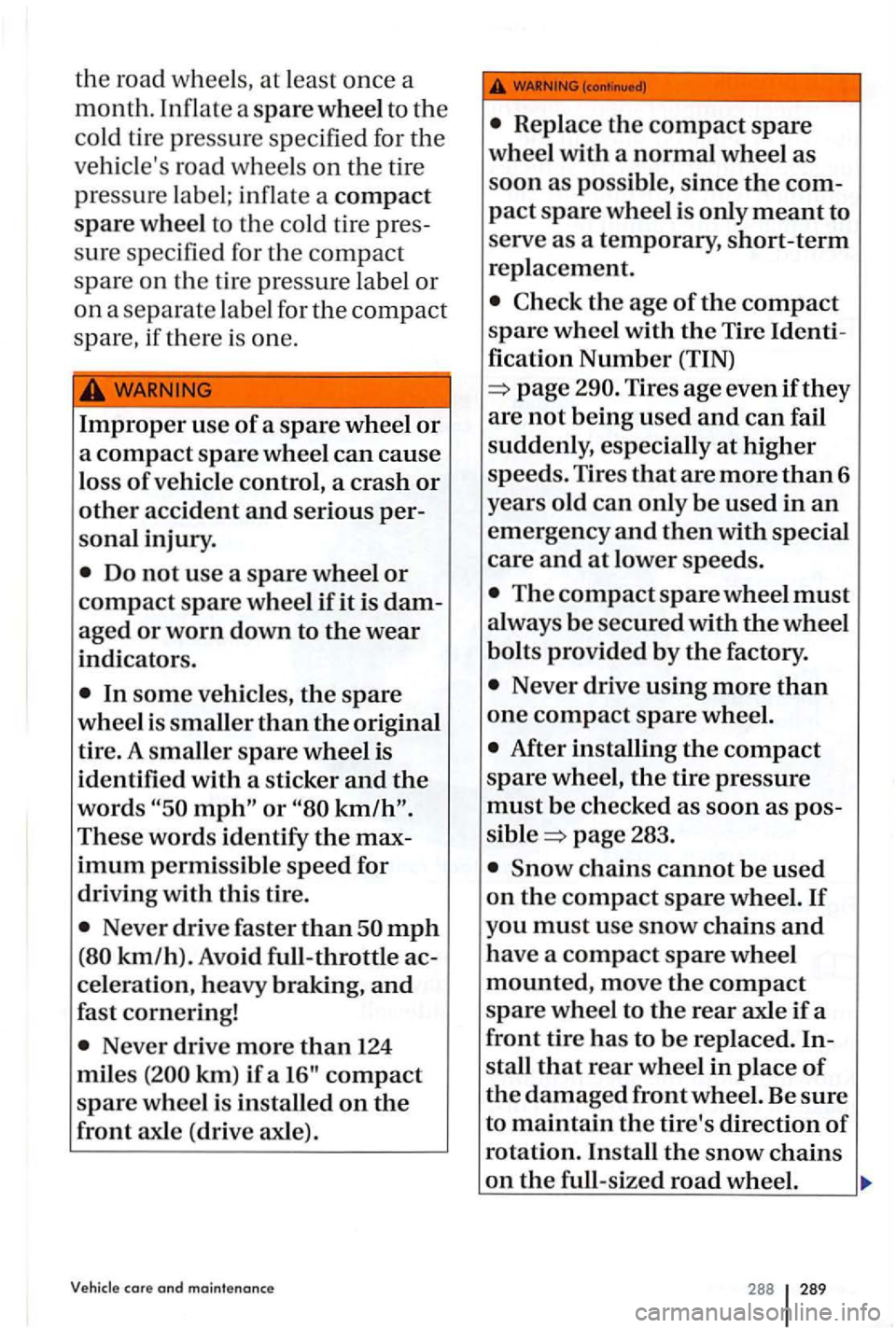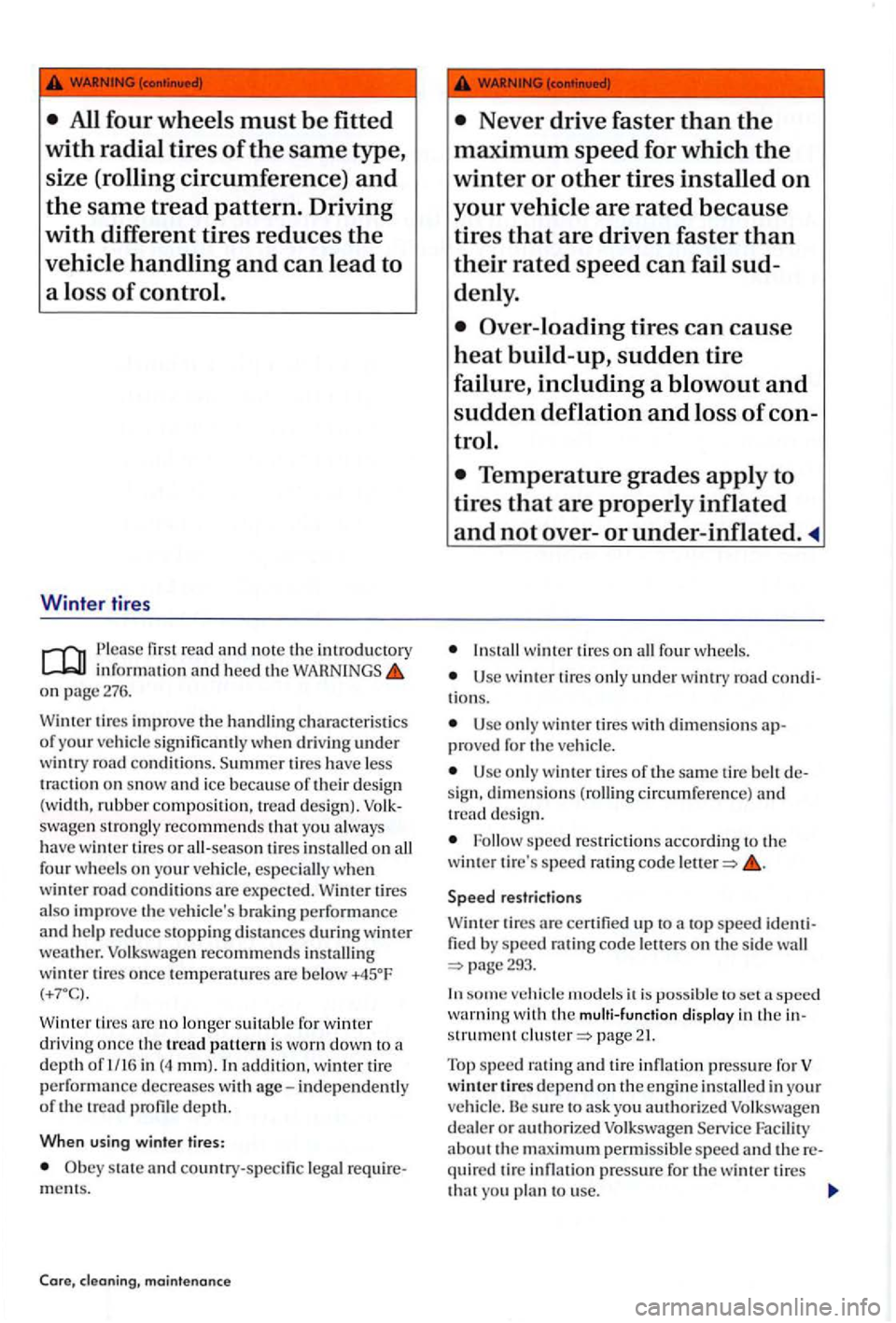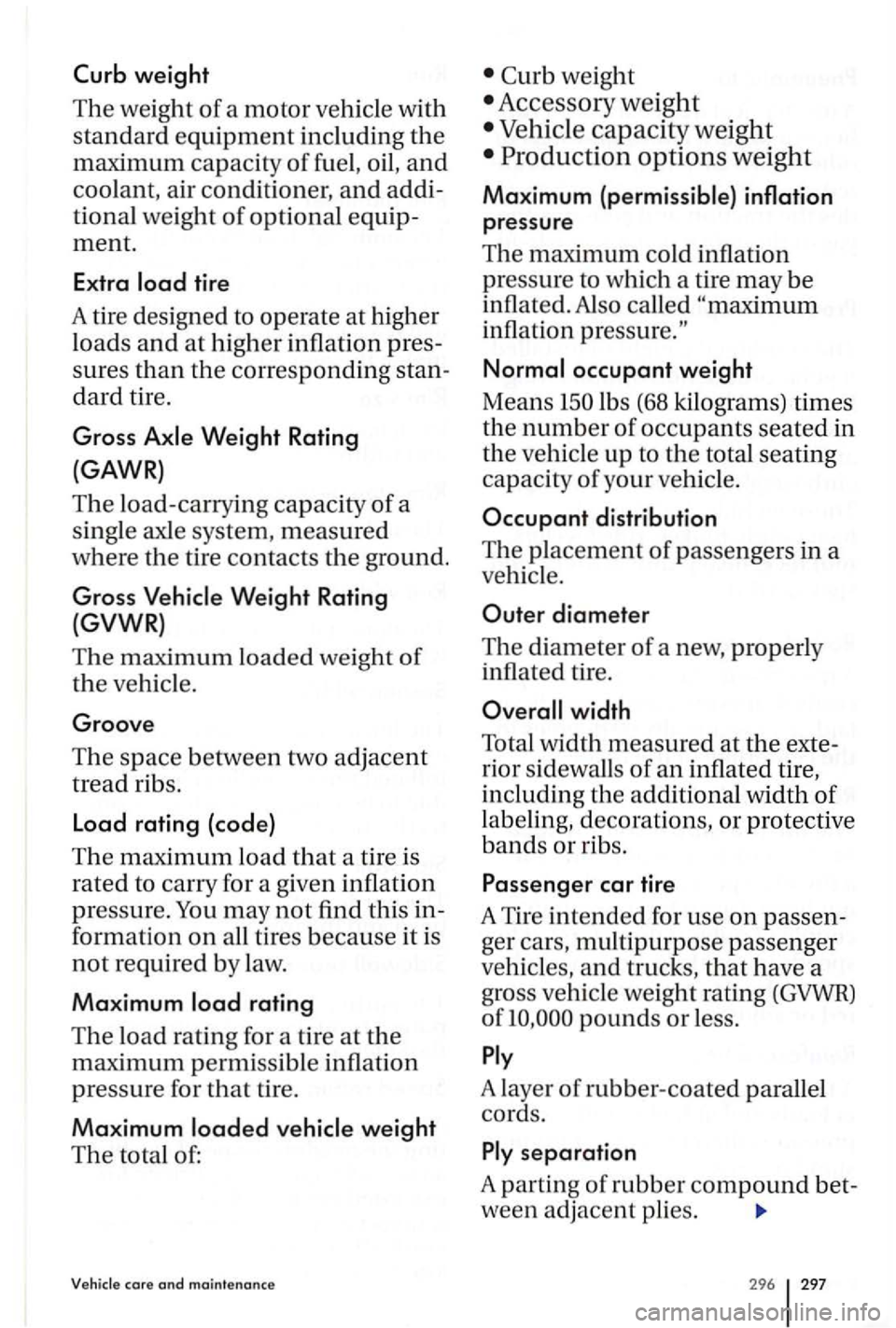Page 280 of 541
Tire
first read and note the
introduc to ry in
formation
a
nd h ee d the WARNINGS on
page 276.
T he c orr ec t tir e infl atio n
pressure
f o r f ac
tory-install ed tires is lis te d
o n a la b el a
nd a ppli es to summer
and wint er tir es. T he la b el
fig. 161 is on the dri ver door
pillar
Chec k tir e infl ati on pressure
r eg ula
rly a nd on cold tires . C heck
al l
the tir es, includin g th e s pare. In
co l
der clim ates tire pressure
s h ould be c hec k
ed more o ften , but
only w hen th e tir es are c old . Al
w ays use an a cc
urate tir e pressure
ga uge .
Afte r adju stin g tl1e tire inflation
pressures, make sure th at the valve
ca ps a re i
nsta ll ed and please read
informati on and m essages about
programming/rese ttin g th e Tir e
282
Page 281 of 541

page220.
Remember that the vehi cle
manufacturer, not the tire manu
facturer, determines the correct
tire
pressu re for the tires on your
ve hicl
e. Never exceed the max
imum inflation pressure listed on
the tire s idewa ll for any reaso n.
Inflat e a
spare wheel to the pres
sure specif i
ed for the vehicle's
road whee ls
on the tire pressure
label; inflate a
compact spare
wheel to the pressure specified for
the compact spare on the tire pres
sure label
or on a separate label for
the compact spare, if there is one.
Incorrect tire pressure can cause
a
sudden tire failure or blowout,
loss
of control, collision, serious
personal injury, and even death.
Always inflate tires to the rec
ommended and correct cold tire
pressure before driving off.
Excessive speed and/or over
loading
can cause heat build-up ,
sudden tire failure including a
blowout
and tread separation
and loss of control.
maintenance
If the tire pressure is too low or
too high, the tires will wear pre
maturely and the vehicle will not
handle well.
Regularly check tire inflation
pressure, at least once a month,
and also especially before a long
trip.
Note
increases fuel
There may be differences be-
tween the pressure readings
from a tire pressure gauge
and the
pressures registered by the Tir e
Monitoring System. The
e lec tronic Tire
Moni-
toring System
is more accurate .
Page 282 of 541
When the Tire
first read and note the introductory information and heed
the on page 276.
Model Engine Tire dimensions Tire pressure
R 16 91 H 34 238
(125 kW)
225145 R
17 91 H 34 238
Golf
l -
The Tire is confi gured at the factory with
the correct tir e inflation pressure applicabl e for the ve hicl e model, en-
g in e
and factory-install ed tire s. This t ire inflation pressure is also listed
on the sticke r insid e the driver page 283 . The tire inflation pres -
s
ure a re listed for all tires and the compact spare wheel. If diff ere n t
tires are
installed, the Tire Monitoring cannot properly
monitor tir e inflation pressures unl ess the is reset to the new tire
page
Informatio n n ot availa b le at t ime o f printing.
Vehicle core and maintenance 284 285
Page 285 of 541

Spare
the compart
ment: Hand
Please first read and note the
introductory information
and heed the WARNINGS on
page 276.
Removing the spare
fig . 163
counter-clockwise and remove the
spare wheel.
Stowing the replaced wheel
Hook the floor cover ing on the
upper edge of the luggage com
partment.
Turn the hand wheel clockwise
until
the wheel replaced is securel y
in place .
Return the vehicle tool kit to its
location in
the luggage compart
ment.
the floor covering and
fold it back down onto the floor of
the luggage compartment.
Close the rear hatch.
Rep lace it with a tire matching the
others on your vehicle as soo n as
poss ible.
Please heed the following:
Do not drive faster than mph
km/h)!
Avoid full-throttle acceleration,
hard braking and fast cornering!
Do not use snow chains on the
compact spare whee l page 295.
After installing the compact
spare wheel, the tire pressure must
b e checked as soon as possib le
283.
Check
the tire inflation pressure of
the spare or compact spare when
ever you ch eck
the tire pressure of
Page 286 of 541

the road wheels , at le a st once a
month. Inflat e a spare wheel to the
cold tire pressure s pecified for the
vehicl e's roa d whee ls on the tir e
press ure la b el; inflat e a compact
spare wheel to the cold tire pres
s
ure s peci fie d for the compact
spare on the tir e pressure label or
on a separate lab el for the compact
spare, if th ere is one .
Improper use of a spare wheel or
a compact spare wheel can cause
loss of vehicle control, a crash or
other accident and serious per
sonal injury.
These words identify the max
imum permissible speed for
driving
with this tire.
Never drive faster than mph
km/h). Avoid full-throttle ac
celeration, heavy braking,
and
fast cornering!
Never drive more than 124
miles km) if a
the age of the compact
spare wheel with the Tire Identi
fication
Number (TIN)
page
The compact spare wheel must
always be secured with the wheel
bolts provided by the factory.
Never drive using more than
one compact spare wheel.
After installing the compact
spare wheel, the tire pressure
must be checked as soon as pos
sible page 283.
288 289
Page 291 of 541

All four wheels must be fitted
with radial tires of the same type,
size (rolling circumference)
and
the same tread pattern. Driving
with different tires reduces the
vehicle handling and can lead to
a los s
of control.
Winter tires
informati o n and heed th e on page 276.
W int er tires im
prove the handli ng c ha ra cte ristics of your ve hicle sig nifi cantly whe n driv in g under wintry of their desig n
(w idth, rubber compositi on, tread desig n). swage n stro ng ly recommend s that yo u always
have w int er tires or all-seaso n tires in stalle d on all
four wheels on yo ur ve hicle, especially when
winter road cond itions are ex pected. W inter tires also improve the ve hicle's braking performance an d help reduce stoppin g d is ta nces d uring winter wea ther. Volkswage n recommends in stalli n g
w inter tires o nce temperatures a re below
Wint er tires are no lo nge r suitabl e fo r w inter
dri vin g o nce the tread pattern is worn down to a
d epth o f 1 /16 in (4 mm). In add ition, w inter tir e
p erformance decreases w ith age- ind ependently
o f the tread
sta te country-specific lega l ments.
Core, maint enance
Never drive faster than the
maximum speed for which the
winter or other tires installed on
your vehicle are rated because
tires that are driven faster than
their rated speed can fail sud
denly.
Over-loading tires can cause
heat build-up, sudden tire
failure, including a
blowout and
sudden deflation and loss of con
trol.
Temperature grades apply to
tires
that are properly inflated
and not over-or under-inflated.
w int er tires on all fo ur wheels .
Use w int er tires only under w in try road
Usc only w inter tires w it h dim en sio n s p roved fo r the veh icle.
Usc only win ter tires of the same t ire belt
speed restri ctio ns acco rding to the
winte r tire's speed ra tin g code
restrictions
W in t
er tires cert ifie d up to a top speed fied by speed p age293.
so me vehicle m odels it is possible to se t a s pee d wa rnin g with the multi-function disploy in the page 21.
Top s peed ratin g and tire infl ation press ure fo r
or a uthorized Volk swagen Service about the m aximum permissib le speed a n d quired tir e infl ation press ure for th e winter tires yo u to use.
Page 294 of 541

Curb weight
The weight of a motor vehicle with
standard equipment including the
maximum capacity of fuel, oil, and
coolant, air conditioner, and addi
tional weight
of optional equip
ment.
Extra load tire
A tire designed to operate at higher
lo
ads and at higher inflation pres
sures than the corresponding stan
dard tire.
Gross Axle Weight Rating
(GAWR)
The load-carryin g capacity of a
single axle system, measured
where the tire contacts the ground.
Gross
The maximum loaded weight of
the vehicle.
Groove
The space between two adjacent
tread rib s.
Load rating (code)
The maximum load that a tir e is
rated to carry for a given inflation
pressure.
You may not find this in
formation on all tires because it is
not required by law.
Maximum load rating
The load rating for a tire at the
maximum permissible inflation
pressure for
that tire.
Maximum loaded vehicle weight
The total of:
Curb weight
Accessory weight
Vehicle capacity weight
Production options weight
Maximum (permissible) inflation
pressure
The maximum cold inflation
pressure
to whic h a tire may be
inflated.
Also ca lled
inflation
Normal occupant weight
Means 150 lbs (68 kilograms) times
the number of occupants seated in
the veh icle
up to the total seating
capacity
of your vehicle.
Occupant distribution
The placement of passengers in a
veh icle.
pounds or less.
Ply
A layer of rubber- coated parallel
cords.
Ply separation
A parting of rubber compound bet-
ween adjacent plies.
296 297
Page 299 of 541
Determining the correct load limit
Please firs t read and note the introductory all ve hicle occupants and lu ggage or other ve hicl e inrormation and heed the pay loa ds. Neve r overload the ve hicle! on page 276.
Do no t over loa d tir es. The rollowi ng example trat es how to dete rm in e the combined we ight or
Load Limit:
1. Locate the statem ent
XXX KG XXX
on your ve hicle's placard (tire inflation pressure la b el)
lb s (5 x =
lb s.)
5. De
termine the combined weight of lu ggage and cargo being
loaded on the ve hicl e. That weight m ay not safely exceed the
ava
ilabl e cargo and lu ggage load capacity calculated in
maintenance